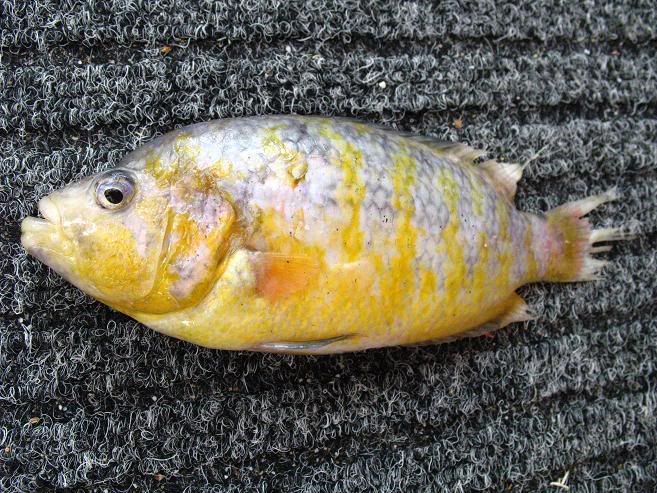First Discribed by Heckel 1840
Found in Central America: Mexico, Guatemala, Honduras, Belize, Costa Rica, Nicaragua .
Size Males: 30cm Female: 25cm
Availability: This fish is now quite rare in Australia and is in danger of being lost to the hobby here.
Sexual differences: Males are larger and generally do not have as vivid colouration as females.
 9731_1166228407791_1590336071_30407830_1134912_n.jpg 40.63KB
95 downloads
9731_1166228407791_1590336071_30407830_1134912_n.jpg 40.63KB
95 downloads Parachromis Friedrichsthalii male Normal Colouration
Diet: Piscivore, diet of high protein, Small fish, insects and shrimp, This fish readily adapts and eats pellets.
P. friedrichsthalii is a benthopelagic fish that inhabits rivers, lowland streams, lakes, lagoons and swamps. It prefers the slow moving, sluggish waters, with clear to murky or muddy water, and is normally found in depths of 1.0-1.5 m, generally no deeper than 2.0 m.
Temperament: Generally a temperament close to that of a Parachromis loiselle, it is not an overwhelmingly aggressive cichlid. It is however territorial and can hold its ground very well..
Breeding: Open spawner, As with typical medium to large cichlids males protect the territory and the female protects the young. Easily bred, follow the guidelines of typical Central American cichlid breeding and you should be fine. In wild it breeds from April to August
Temperature: 75-82 degrees Fahrenheit
pH: 7-7.5
Hardness medium to hard,
General Information: Have been in the hobby since 1914, give this cichlid plenty of hiding places. The tank can be planted, as they are typically not abusive to vegetation. The lighting of tank should not be over-powering, as in most New World cichlids live in the darker parts of their habitats.
In my experience this fish to be very slow growing. They do well when housed with other medium sized cichlids that are not aggressive.
This species is very similar in appearance to P.motaguensis and P.loisellei. The primary difference is the broken lateral barring in P.friedrichsthalii which is solid on the P. Loisellei. The body shape of Friedrichsthalii is more elongated and barrel shaped, instead of tall and round like P.loisellei. P.motaguensis closely resembles P.friedrichsthalii differing in the cheek patterning , the adult male coloration and a more elongated body. Female P.friedrichsthalii show strong vertical barring with a bright yellow background. Males can vary from a dark copper to a brownish-yellow. The males exhibit dark spotting in the fins, flanks, and chin. In the aquarium trade the Xhantocromic form is very popular. This is where he fish loose pigmentation and just show yellow colouration.
P. Friedrichsthalii exhibit pseudocanine teeth that are used for holding onto prey. These teeth can do serious damage in a short time to tankmates and to eachother.
Xhantochromic Male and Female;
Xanthochromism (also called xanthism) is a term that may be applied to birds, fish and other animals whose colouration is unusually yellow through an excess of yellow pigment, or possibly a loss of darker pigments that allows yellow pigment to be unusually dominant. It is often associated with the lack of usual red pigmentation and its replacement with yellow. The cause is usually genetic
 Freddie_AdultM_X3120136.jpg 157.7KB
81 downloads Male
Freddie_AdultM_X3120136.jpg 157.7KB
81 downloads Male  Freddie_Fem_Adult_X3120155.jpg 1.84MB
63 downloads female
Freddie_Fem_Adult_X3120155.jpg 1.84MB
63 downloads female Breeding:
As with most pair forming cichlids, the best method of getting a pair is to purchase 6-10 juveniles and let them develop their own pair bonds. The fish will start pairing off at 8-10cm in length. Pair bonds are not as strong as some of the other fish in the genus. The male can become very aggressive and abusive if the female is not ready to breed, so the use of dither fish is recommended. The male will begin displaying to the female. The pair will begin to clean a flat surface if the female is responsive of the male's previous courting behavior. The female will then lay approximately 500 – 1000 orange coloured eggs which will then be fertilized by the male. The eggs will be viciously guarded by both parents and a high degree of parental care is show to the eggs and fry. Eggs will hatch after approximately 3 days. The Parents will tend to move the fry between various pre dug pits. Fry are generally free swimming after day 6-7can be fed with baby brine shrimp, micro worms or commercial fry food. Fry can be raised separately, however caution is recommended as this can interrupt the breeding cycle and cause the male to want to spawn again with the female before she is ready, and the male may injure or kill the female while attempting to force her to spawn. Fry grow at different rates and cannabilism is common, fry should be segregated depending on size.A well conditioned pair can spawn every 3-5 weeks.
Unusual Hunting Technique:
These fish are an ambush preditor, lieing motionless in wait for their prey to venture to close where they can strike with amazing speed. However as this study published ( Journal of Fish Biology (2005) 66, 877–881 M. TOBLER) in 2005 shows, the Central American Cichlid Parachromis friedrichsthalii has been observed "playing dead" in the wild to lure prey within strike range very similar to the behavior of N. livingstonii of lake Malawi. The fish lie motionless on the bottom and allow small fish to pick at them until they venture near to their head when they suddenly lunge and grab their prey
"Parachromis friedrichsthalii has an unusual hunting mechanism. The species has been observed to lie immobile near the bottom, feining death. When smaller fish approach and attempt to pick at the dead fish, P. friedrichsthalii ambush the smaller fish. Similar behaviour has also been observed in some species of Lake Malawi cichlids, particularly from the genus Nimbochromis."
 Freddie_Adult_Fem_N3120147.jpg 164.2KB
72 downloads
Freddie_Adult_Fem_N3120147.jpg 164.2KB
72 downloadsA Female Friedrichsthalii showing a change of colouration from the normal dark lines on a yellow background to the Xhnatochromic Yellow and white.
This desirable genetic trait makes this fish an extremely attractive addition to the central American aquarium.














